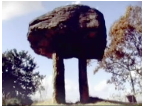This study investigates the characteristics of memorial services that reflect the normativity of funeral rituals that took place at the time, which in turn can shed light on the patterns associated with the formation process of tomb traditions. This i...
http://chineseinput.net/에서 pinyin(병음)방식으로 중국어를 변환할 수 있습니다.
변환된 중국어를 복사하여 사용하시면 됩니다.
- 中文 을 입력하시려면 zhongwen을 입력하시고 space를누르시면됩니다.
- 北京 을 입력하시려면 beijing을 입력하시고 space를 누르시면 됩니다.

금강하류지역 청동기시대 묘제의 제사·의례적 성격 고찰 = Study on the Characteristics of Rituals at Bronze Age Tombs in the Lower Reaches of the Geum River
한글로보기https://www.riss.kr/link?id=A108404321
-
저자
오대양 (단국대학교)
- 발행기관
- 학술지명
- 권호사항
-
발행연도
2022
-
작성언어
Korean
-
주제어
금강하류 ; 청동기시대 ; 송국리형묘제 ; 제의 ; 고인돌 ; 석관묘 ; 시조신앙 ; Lower reaches of the Geum River ; Bronze Age ; Songgukri-type tombs ; Ritual ; Dolmen ; Stone coffin tombs ; Religion of the Founding Fathers
-
등재정보
KCI우수등재
-
자료형태
학술저널
-
수록면
731-760(30쪽)
- 제공처
-
0
상세조회 -
0
다운로드
부가정보
다국어 초록 (Multilingual Abstract)
This study investigates the characteristics of memorial services that reflect the normativity of funeral rituals that took place at the time, which in turn can shed light on the patterns associated with the formation process of tomb traditions. This is done by comparing the tomb system dating to the Bronze Age in the lower reaches of the Geum River to those of the other regions. First, the religious philosophy of the society reflected in the tomb system dating to the Bronze Age in the lower reaches of the Geum River was examined, and the aspects of ancestral rites and ritual services were reviewed and their correlations with the dolmen traditions considered. As a result, it was possible to arrive at an understanding of the layout of the tombs of Songguk-ri society, where dolmens and ‘Songguk-ri type tombs’ coexisted, as well as of their mutual relationships, and the functional layout of space where these structures were located. Second, it was explored how the tradition of the tomb system of Songguk-ri society had been based on the material, mental, and cultural network of diverse forms that that existed beforehand in the Liaodong region and the southern part of North Korea. The formation of the tomb system of Songguk-ri society was seen to have been based on the expansion of a consensus, in which religious motifs associated with the myth on Founding Fathers had been shared. It was observed that the growth of complex tomb systems where tombs of diverse forms coexisted had resulted from the expressions of regional characteristics of the earlier culture of the southwestern part of southern Korea. It was concluded that this may have been the result of the strategic choice made by the leaders of Songguk-ri society who sought to stabilize society based on the belief in the Founding Fathers, at a key turning point in terms of society. The tradition of the tomb system of Songguk-ri society in the lower reaches of the Geum River may have been rebuilt as a way of emphasizing their acceptance of the common myth of the Founding Fathers, utilizing the network consisting of the dolmen tradition, ancestral rites, and ritual services that had been formed earlier in the Liaodong region, the southern part of North Korea, and the southwestern part (Hoseo region) of South Korea.
동일학술지(권/호) 다른 논문
-
조영동고분군 출토 인골과 동물 뼈의 분석을 통한 고대 경산지역의 계층별 식단 복원
- 한국고고학회
- 최경철
- 2022
- KCI우수등재
-
2~4세기 사로권역 철기의 부장체계 조직화와 위세경제 소비 구조
- 한국고고학회
- 장기명
- 2022
- KCI우수등재
-
- 한국고고학회
- 하승철
- 2022
- KCI우수등재
-
기하학적 형태측정법을 이용한 영산강 마한 일상토기 생산체계에 대한 예비적 고찰: 심발을 중심으로
- 한국고고학회
- 허진아
- 2022
- KCI우수등재




 스콜라
스콜라






